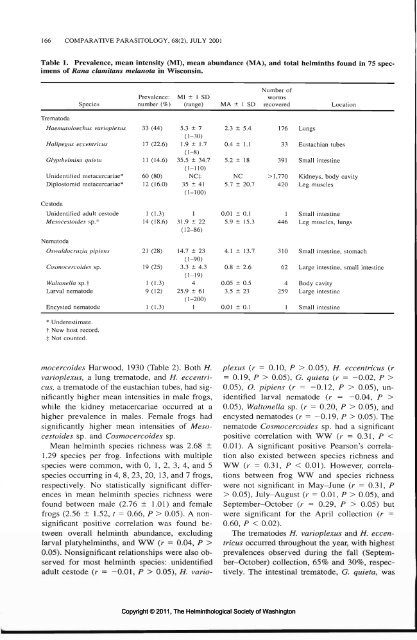Comparative Parasitology 68(2) 2001 - Peru State College
Comparative Parasitology 68(2) 2001 - Peru State College
Comparative Parasitology 68(2) 2001 - Peru State College
Create successful ePaper yourself
Turn your PDF publications into a flip-book with our unique Google optimized e-Paper software.
166 COMPARATIVE PARASITOLOGY, <strong>68</strong>(2), JULY <strong>2001</strong><br />
Table 1. Prevalence, mean intensity (MI), mean abundance (MA), and total helminths found in 75 specimens<br />
of Rana clamitans melanota in Wisconsin.<br />
Trematoda<br />
Species<br />
Haematoloechus varioplexus<br />
Halipegus eccentricus<br />
Glypthelmins quieta<br />
Unidentified metacercariae:i:<br />
Diplostomid metacercariae*<br />
Cestoda<br />
Unidentified adult cestode<br />
Mesocestoides sp.*<br />
Nematoda<br />
Oswaldocruzia pipiens<br />
Cosmoccrcoides sp.<br />
Waltonclla sp.t<br />
Larval nematode<br />
Encysted nematode<br />
* Underestimate.<br />
t New host record.<br />
± Not counted.<br />
Prevalence: MI ± 1 SD<br />
Number of<br />
worms<br />
number (%) (range) MA ± 1 SD recovered<br />
33 (44)<br />
17 (22.6)<br />
11 (14.6)<br />
60 (80)<br />
12 (16.0)<br />
1 (1.3)<br />
14 (18.6)<br />
21 (28)<br />
19 (25)<br />
1 (1.3)<br />
9 (12)<br />
1 (1.3)<br />
5.3 ± 7<br />
d-30)<br />
1.9 ± 1.7<br />
(1-8)<br />
35.5 ± 34.7<br />
(1-110)<br />
NC:i:<br />
35 ± 41<br />
(1-100)<br />
1<br />
31.9 ± 22<br />
(12-86)<br />
14.7 ± 23<br />
(1-90)<br />
3.3 ± 4.3<br />
(1-19)<br />
4<br />
25.9 ± 61<br />
(1-200)<br />
1<br />
mocercoides Harwood, 1930 (Table 2). Both H.<br />
varioplexus, a lung trematode, and H. eccentricus,<br />
a trematode of the eustachian tubes, had significantly<br />
higher mean intensities in male frogs,<br />
while the kidney metacercariae occurred at a<br />
higher prevalence in males. Female frogs had<br />
significantly higher mean intensities of Mesocestoides<br />
sp. and Cosmocercoides sp.<br />
Mean helminth species richness was 2.<strong>68</strong> ±<br />
1.29 species per frog. Infections with multiple<br />
species were common, with 0, 1,2, 3, 4, and 5<br />
species occurring in 4, 8, 23, 20, 13, and 7 frogs,<br />
respectively. No statistically significant differences<br />
in mean helminth species richness were<br />
found between male (2.76 ± 1.01) and female<br />
frogs (2.56 ± 1.52, t = 0.66, P > 0.05). A nonsignificant<br />
positive correlation was found between<br />
overall helminth abundance, excluding<br />
larval platyhelminths, and WW (/• = 0.04, P ><br />
0.05). Nonsignificant relationships were also observed<br />
for most helminth species: unidentified<br />
adult cestode (r = -0.01, P > 0.05), H. vario-<br />
2.3 ± 5.4<br />
0.4 ± 1.1<br />
5.2 ± 18<br />
NC<br />
5.7 ± 20.7<br />
0.01 ± 0.1<br />
5.9 ± 15.3<br />
4.1 ± 13.7<br />
0.8 ± 2.6<br />
0.05 ± 0.5<br />
3.5 ± 23<br />
0.01<br />
± 0.1<br />
176<br />
33<br />
391<br />
> 1,770<br />
420<br />
1<br />
446<br />
310<br />
62<br />
4<br />
259<br />
Copyright © 2011, The Helminthological Society of Washington<br />
1<br />
Lungs<br />
Location<br />
Eustachian tubes<br />
Small intestine<br />
Kidneys, body cavity<br />
Leg muscles<br />
Small intestine<br />
Leg muscles, lungs<br />
Small intestine, stomach<br />
Large intestine, small intestine<br />
Body cavity<br />
Large intestine<br />
Small intestine<br />
plexus (r = 0.10, P > 0.05), H. eccentricus (r<br />
= 0.19, P > 0.05), G. quieta (r = -0.02, P ><br />
0.05), O. pipiens (r = -0.12, P > 0.05), unidentified<br />
larval nematode (r = -0.04, P ><br />
0.05), Waltonella sp. (r = 0.20, P > 0.05), and<br />
encysted nematodes (r = -0.19, P > 0.05). The<br />
nematode Cosmocercoides sp. had a significant<br />
positive correlation with WW (/• = 0.31, P <<br />
0.01). A significant positive Pearson's correlation<br />
also existed between species richness and<br />
WW (r = 0.31, P < 0.01). However, correlations<br />
between frog WW and species richness<br />
were not significant in May—June (/• = 0.31, P<br />
> 0.05), July-August (r = 0.01, P > 0.05), and<br />
September-October (/- = 0.29, P > 0.05) but<br />
were significant for the April collection (r =<br />
0.60, P < 0.02).<br />
The trematodes H. varioplexus and H. eccentricus<br />
occurred throughout the year, with highest<br />
prevalences observed during the fall (September-October)<br />
collection, 65% and 30%, respectively.<br />
The intestinal trematode, G. quieta, was
















